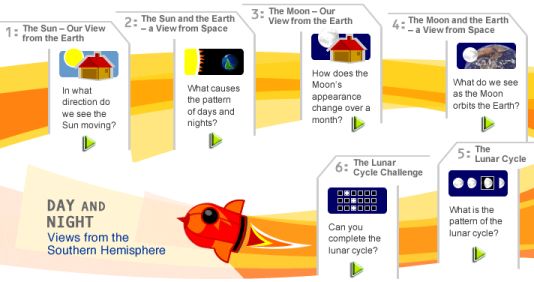You are here:
- Home »
- Nature of science »
- Nature of science teaching activities »
- Using online models to understand the phases of the Moon
Using online models to understand the phases of the Moon
Rationale
The changing appearance of the Moon is determined by the relative positions of the Moon, Earth and Sun.
A model allows students to see how the relative positions of the Moon, Earth and Sun affect the appearance of the moon. Scientific explanations are often in the form of a model.
What you need
- Day and Night: Views from the Southern Hemisphere

Day and Night: Views from the Southern Hemisphere
Focus
- How have earlier humans explained the changing appearance of the Moon?
- How would scientists have generated their current views of Moon phases?
- What do you think scientists mean by ‘models’?
- Why would it be difficult to investigate and represent moon phases without models?
- What are some ways in which you could represent the phases of the Moon?
- What do we know about what causes the phases of the Moon?
Exploration
- As a class, in groups or individually, click on this link Day and Night: Views from the Southern Hemisphere.
- Select ‘3: The Moon – our View from the Earth’. This animation demonstrates how the Moon’s appearance changes over a month.
- For a view of the Moon orbiting the Earth from space, click the ‘Blast Off’ link – this will take you to the next animation: ‘4: The Moon and the Earth – a View from Space’.
- To view the lunar cycle, click on the ‘Home’ link (to return to the home page), and click on the ‘5: The Lunar Cycle’, or ‘6: The Lunar Cycle Challenge’.
Reflection
- How did scientists work out this model before modern technology was available?
- How does this model help you investigate a theory that is already well known to scientists?
- What other models could we develop to show the Earth/Moon/Sun relationships?
- In Day and Night: Views from the Southern Hemisphere:
- What aspects of the Earth, Moon, and Sun are modelled? (For example, relative positions, rotations, orbits, shapes, some surface features)
- What aspects of the Earth, Moon, and Sun are deliberately not addressed by these graphics? (For example, composition, atmospheres, mass.)
- In what ways are the graphics different from representations in textbooks?
- Discuss the onscreen questions and information.
Activity resources
Day and Night: Views from the Southern Hemisphere
- This interactive resource is designed to clarify students’ understanding of why the Sun and the Moon both seem to move across the sky and why the Moon seems to gradually change shape.
- It has a southern hemisphere perspective, with images, times, cycles, and phases of a theoretical (average) month.
- Seasonal variation is not allowed for.
- You may need to download the Shockwave program to view the resource.
- If you have access to a data projector, you may find it easier to use this to guide the students through the animation.
Please refer to the Ministry’s online school resources catalogue,
Down the back of the chair
or contact:
Wickliffe Ltd
Freephone: 0800 660 662
Freefax: 0800 660 663
Email:
[email protected]

